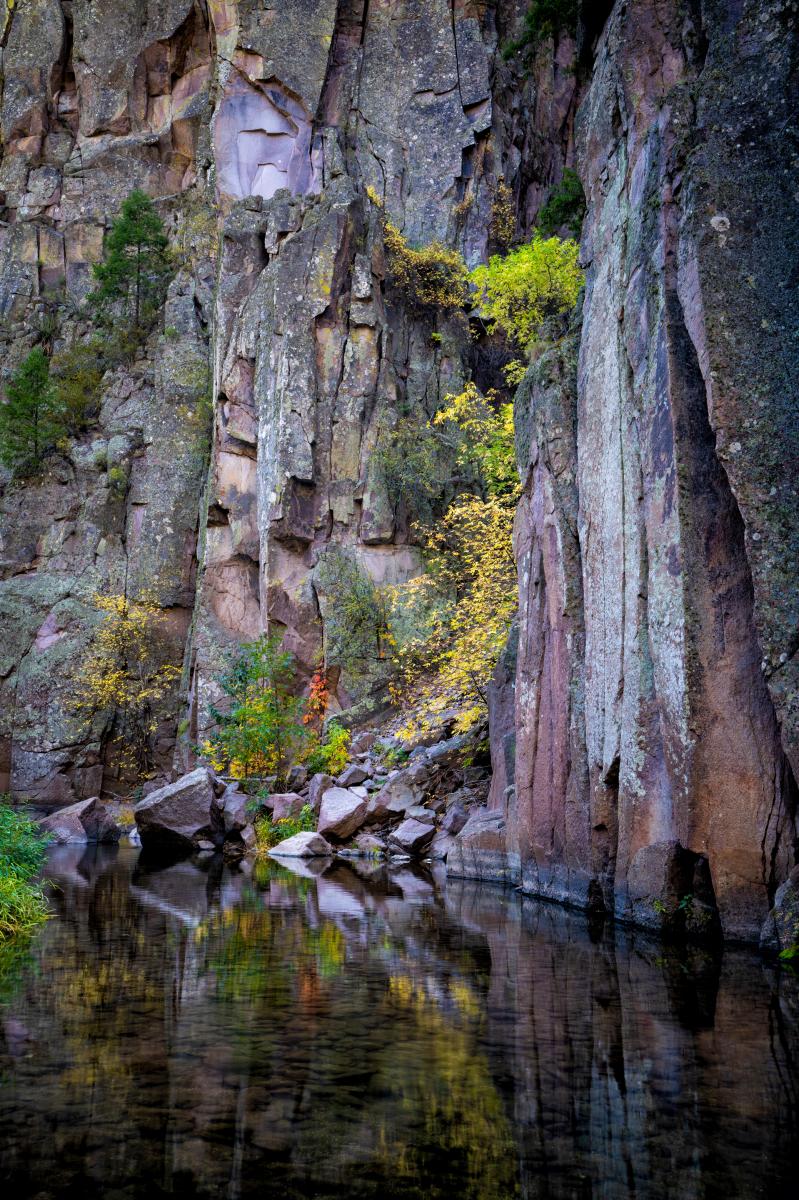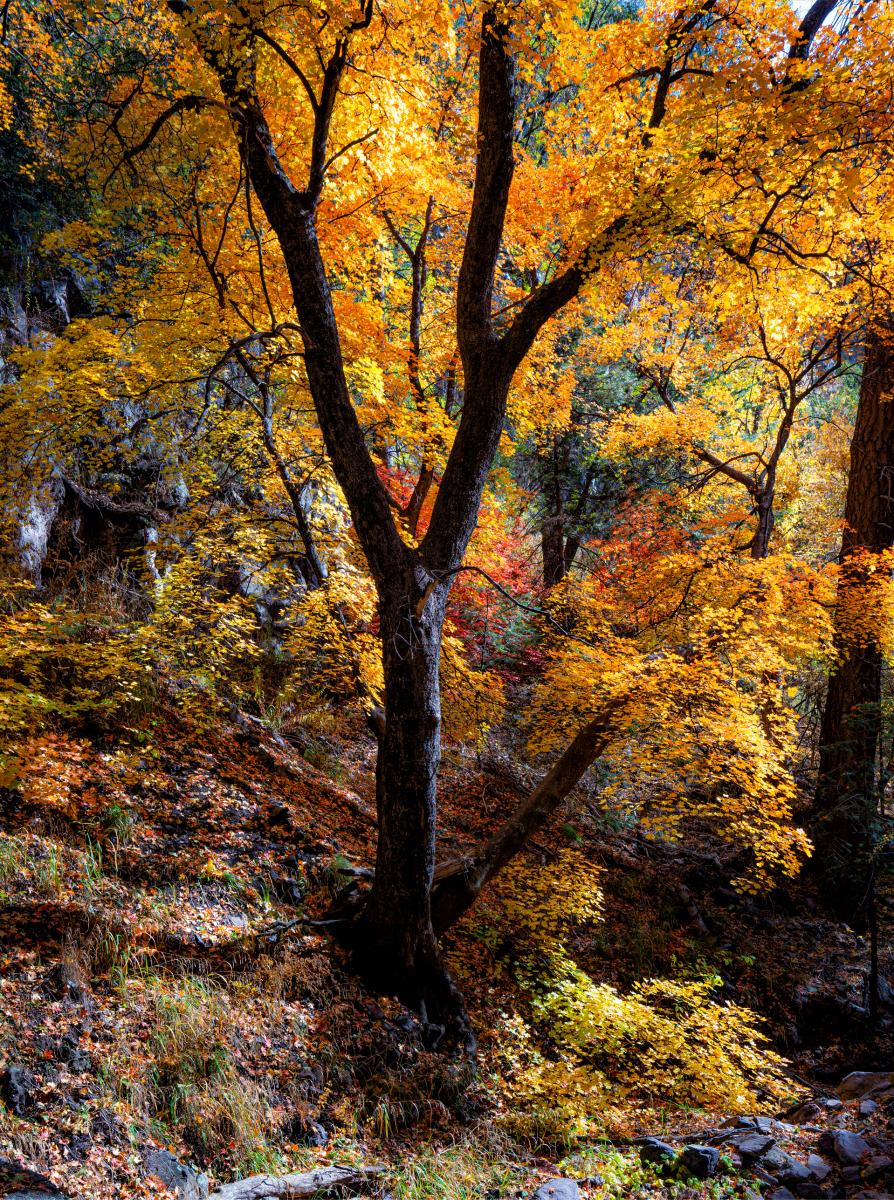On a cool October morning in southwestern New Mexico, mist from Snow Lake drifts into the golden grasses along the trail. Brushstrokes of rose and blue dance across the water, reflecting the predawn sky. In the silvered lake, a great blue heron moves so slowly that its foot doesn’t cause a ripple when it breaks the glassy surface. A bull elk bugles into the crisp morning air. Wolves live in these woods as well. I have heard them howl from the ridges and seen their cinnamon-speckled coats disappear into the trees on past visits to the Gila National Forest.
I crest the dam as the sun breaks the horizon over the Gila River Canyon and lights up yellow and orange aspens, colorful walnuts and oaks, and a blanket of red sumac. The serene expanse of the Gila delivers a balm for the soul—especially in the fall.
When I arrive back at the campground, adjacent to the lake, families warm themselves by morning fires. One group loads heavy backpacks for an eight-day, 44-mile trek south to Gila Cliff Dwellings National Monument. Walking some of the highest trails in the Gila Wilderness, they’ll encounter paths of gold through the vast groves of aspen capping the peaks of the Mogollon Mountains.
My family and I dream of such an adventure, but for now we’re content to spend a long weekend skirting the wilderness looking for hot spots of fall color. The Greater Gila Bioregion, an expanse of 3.3 million acres that includes the Gila, Aldo Leopold, and Blue Range wildernesses, is larger and more biodiverse than Yellowstone National Park. “And none of it is easy to get to,” says Elroy Limmer, a photographer and past president of the Gila Native Plant Society.

Sheer canyon walls along the Gila River provide a canvas for colorful leafy surprises.
Catching the long unfolding of fall in southern New Mexico requires ample driving and time. It starts with the golden flush of aspens on the high peaks in early October, followed in November by cottonwoods, sycamores, and other water-loving plants that color the rivers and creeks spilling out from the mountains onto the brown skin of the grasslands. The finale occurs in early December, when color invades the lower box canyons.
After a couple days of hiking, paddling, fishing, and wildlife watching along the northern boundary of the Gila Wilderness, we take Bursum Road to our next stop. The condition of the narrow, winding forest road is notoriously in flux: sometimes washed out, on occasion unpassable, and in the winter closed. Singular colorful aspens and oak trees stand out among the dark evergreen forest along the drive. The real treasure we are seeking lights up the canyons as we approach Mogollon. The former mining outpost turned tourist attraction closes its art gallery, mining museum, antique store, and café at the end of summer, just when the maples blaze fire-engine red, scarlet creeps into the ivy, and aspens, walnuts, and oaks start their fall show. To get the best view, we drive our high-clearance 4-by-4 to the historic cemetery above town. At viewpoints along the way, we delight in the gold and red leaves spreading through the green valley below as the Mogollon peaks glimmer in their aspen-covered glory.
 The Gila National Forest shimmers with golden Aspen leaves.
The Gila National Forest shimmers with golden Aspen leaves.
From Mogollon we weave down the mountains on the final stretch of Bursum Road to Glenwood and the nearby Catwalk National Recreation Trail. Perched a dozen feet above the water, a series of bridges and pathways wend along the contours of the creek as it cuts through the canyon. Dramatic canyons lead us to hidden pools and waterfalls. An impeccably camouflaged reddish-gray canyon tree frog jumps off a boulder as I pass too close. Rare Gila trout, recently reintroduced to these waters, swim against the current in the pools and riffles.
What grabs our attention most is the huge Arizona sycamores, a species found only in the Southwest, at the mouth of the canyon. Gray and sage bark decorates their thick, twisted branches, loaded with large, luminous orange and brick-red leaves. Sycamores on either side of the water form a canopy over Whitewater Creek.
The original catwalk was rebuilt in 2013 after a catastrophic flood that followed the Whitewater-Baldy wildfire ripped it out of the canyon. The sycamores, however, survived. In several high-walled canyons of the Gila, such as Little Dry, Big Dry, and Mineral Creek, these warrior sycamores thrive and grow to heights of 80 feet.

Native trees, shrubs, and ivy erupt in tones that range from pale yellow to a deep burgundy.
The next morning, we drive north to the famed Adobe Café & Bakery, on US 180 outside the small town of Reserve, where warm, made-from-scratch cinnamon buns dripping with sweet frosting do not disappoint.
That afternoon, we pull onto the sandy flats of the Nature Conservancy’s Gila Riparian Preserve. More than 1,200 protected acres stretch along the Gila River, the last free-flowing river in the Southwest. Radiant yellow cottonwoods and golden willows grow thick and tall in the floodplain. In addition to leaf peepers, birders flock to this preserve for a chance to spot the more than 300 winged species found in this area, including the rare southwestern willow flycatcher.
“People also get excited about seeing javelina, gray foxes, and coatimundi on the preserve,” says Martha Cooper, the conservancy’s southwest New Mexico field representative. We spend the afternoon exploring the sandy riverbanks, looking for animal tracks and skipping rocks.
After many years of visiting the Gila, I’ve learned that I never find the same place twice. “Finding fall color depends on how much rain we get, what gets burned in wildfires, and what’s washed out by flooding,” says Limmer.
Whatever the leaves are doing, the rugged mountains, high-walled canyons, and river plains of the Gila always serve up a vibrant adventure.


